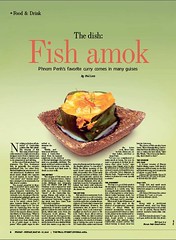Nothing polarizes aficionados of Cambodian cuisine like fish amok. The ubiquity of this fish curry, which is typically steamed to a light mousse in a wrapper made from a banana leaf, belies a vast range of approaches to its preparation and serving.
At the core of fish amok are four elements. The first, freshwater fish, is generally the endemic snakehead fish, but other firm-fleshed freshwater creatures are often substituted; freshwater snail amok (amok chouk) also appears on local menus. In recent times ‘tofu amok’ and ‘chicken amok’ have emerged as an alternative for fish-averse tourists.
The second essential is kroeung, a pounded spice paste that contains a heavy dose of lemongrass alongside Cambodian fermented fish paste (prahok), fresh turmeric root, the ginger-like rhizome krachai, galangal, garlic and red shallots. Chili? ‘Some people use it for amok; others don’t,’ says Joannès Rivière, author of Cambodian recipe book ‘La Cuisine du Cambodge Avec les Apprentis de Sala Baï’ and executive chef of upscale Khmer restaurant Meric in Siem Reap. ‘What is sure is that it shouldn’t be fresh chili but always dried. Just soak them and chop them thinly, using a bit of palm sugar to make a paste.’ More palm sugar is also added to sweeten the curry.
Thirdly, and what most differentiates a Cambodian amok from its regional neighbors, is the addition of the herb slok ngor (the leaf of the noni tree, morinda citrifolia). The small ovoid leaf confers a subtle but distinctive bitterness to the dish.
The fourth and final must is fresh coconut milk.
So writes and photographs me(!) for today’s Wall Street Journal Asia. Sorry for no link to the rest of the article wherein I speculate at amok’s history and the reasons why it is rarely cooked at home , WSJ Asia is subscription-only.
Addendum (12 June 2007): Full fish amok article is now online at WSJ.com

Excellent work, Phil! Congrats!
Congrats! From blog to blarticle, will we see a blook someday?
http://www.lulublookerprize.com
BTW Phil, for those of us whose AWSJ just happened not to arrive this am (grrr) — can you share the names/coordinates of the amok hotspots that you list in the article (can’t quite read the tiny print in your reproduction).
Congrats, Phil – that’s really excellent news.
It would be somewhat ironic if the Cambodia Daily were to re-run it as, say, a weekend edition piece…
Phil I just read the article which I found on one of Cambodia’s online news sites not known for its respect for intellectual property rights. Excellent article by the way….but where is one to find the slok ngor leaf outside of Cambodia. I know Joannes is a slavish traditionalist, he is French afterall, but does not having this obscure leaf really put other versions out of the ‘authenticity’ running?
Dear Maytel
I have a slavish traditionalist only when it comes to write “traditional fish amok” on a board oustide a restaurant in Cambodia. Everywhere else in the world instead of noni leaf I use swisschard or spinach.
Noni is widely available throughout Polynesia, particularly in Hawaii, where almost all parts of the plant (including the leaves) have long been prized for their medicinal qualities. Hawaiians have used noni since ancient times to treat everything from bug bites to mercury poisoning to lung cancer.